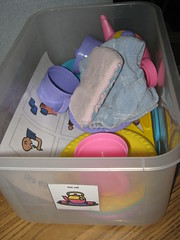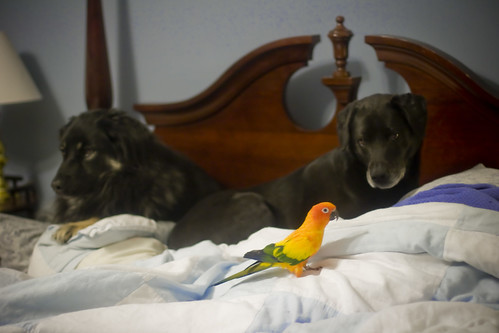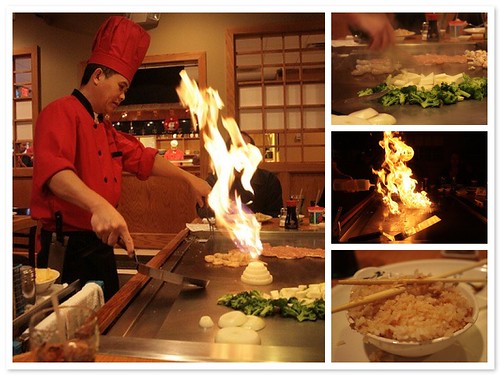I work so hard on these, and spend so much time on them, that I feel like they need to be on display somewhere for the world to see LOL
Seriously - Maybe it will help someone to see an example of my weekly lesson plans :-)
The template is adapted from one our principal gave us to use a few years ago.
Click here to see my LPs for the week of August 19th
Lesson Plans
Re-invigorated
The last couple of years I have been afraid I'm hitting that burn-out stage that everyone talks about. I still love my job, I still love my kiddos, but the paperwork and bureaucracy aspects of the job have started getting to me. I have neglected my blog (this one and, to an extent, my classroom one) and some of the more creative and enjoyable things related to my job and been doing just what has to be done (which, granted, in my over-achieving case is arguably quite a bit more than the bare minimum for most people but still makes me feel a little like a slacker).
This weekend I attended the Autism Society of America national conference in Pittsburgh and am feeling excited about work again - genuine excitement! More than that, I've been re-inspired to be an active member of the autism community and share - which means a renewed commitment to blogging here. Hold me accountable!! I'm at the airport, right now, about to board the flight home, but wanted to at least take the time to write a quick note putting my commitment into writing. I will be back to blog about the conference, things I learned about at the conference, new ideas I have, and share more about what I already do. I was reminded this weekend that I do have a lot of valuable knowledge, information, resources, and ideas that I should share with others. By no means am I an expert (is there such thing as an autism expert? not in my opinion!) and I have plenty left to learn!
Topics I plan to write about in the near future include
- a recap of the conference
- collaborating with other professionals (OT/PT/SLP)
- parent/teacher communication and partnership
- technology and its use in the classroom (assistive tech and regular tech)
- classroom logistics - scheduling, lesson planning, data collection, etc.
- I'm finishing up my dissertation so I can share LOTS about the research in stereotypy ... but that will have to be later because I have had just about all of that I can take for now :-)
EVERY child deserves a fun summer!
Once a year, I "spam" my blog with this request. If you could share the link (www.gofundme.com/campmays) I would greatly appreciate it!!
Go to www.campmays.com to learn more, or visit our facebook page
PLEASE feel free to share this link - Camp Mays is funded 100% through donations! Every little bit helps!!
My students' parents face several challenges once school is out for the summer. While summer break is, for most kids and families, full of opportunities and fun, that's not the case a lot of the time with my students. It is often difficult if not impossible for parents to find a babysitter or child care provider who is qualified and willing to care for some of my students so their parents have almost two months with no break at all from caring for their child - a child who requires constant active supervision. Additionally, many of my students' parents spend so much time, money and energy just providing everyday care for their kids that they often have little time, money or energy left over to do "fun" things.
In an effort to provide some respite for my students’ parents and provide some opportunities for "typical" summer fun experiences for my students over the summer months, a few years ago I began taking my students on day trips to places like White Water, Children's Museums, parks, etc. What has evolved has been dubbed “Camp Mays”. I rent a van each week and take my students (along with several of my friends, family and coworkers who volunteer to help) to places like the movies, Jungle Jumpers, Stone Mountain, the Georgia Aquarium, and swimming. Some of my students' families may not have otherwise been able to provide these opportunities for their child. In the beginning I funded “Camp Mays” almost solely from my own pocket – purchasing the admission tickets, renting the van, buying the gas, and buying lunch for each child and volunteer. Families do not have to pay anything at all for their child to be able to participate in Camp Mays. In each of the first two years I spent over $3000 of my own money on Camp Mays. In 2011, I recieved over $1000 in generous donations and spent over $2000 on top of that. Last year I raised over $3000 in donations!! Because I get new students each year, and don't want to exclude former students who have moved on to middle school or moved to other schools in the county, Camp Mays grows each year. This year I am expecting to have 25 students with disabilities, which means I will need more volunteers. I will need a bus instead of a van!
I feel that these opportunities provide such a great service to my students and their families – mainly giving the parents a small break from the extreme demands that a child with a disability presents almost constantly and providing opportunities for my students to participate in fun activities just like other children.
Please visit www.campmays.com to learn more and see photos from previous adventures. 100% of all money collected will go directly towards... van rental, gas, admission tickets, lunch, and/or snacks.
Easter fun
Wow - it's been a while since I've blogged. There have been a lot of changes in my professional life, but really things aren't that different. Our county created MOID classes at three other schools and there is now only one at my school. One of the MOID teachers moved to the SID/PID class, one moved to gen ed kindergarten. The SID/PID teacher moved to the MOID class at another school, and both of my paraprofessionals were sent to another school. All of the students were sent to the program closest to their home school, so I lost 5 students and gained several from the other MOID classes. My classroom is no longer a MOID class disguised as an AU class (or vice versa). I have two students who do not have any ASD diagnosis (I had three but one moved) but the other 7 are on the spectrum, which is why I say it's really not that different.
Anyway, I feel like I've neglected this blog - even though I'm not strictly an "autism teacher" this year, I still realize that most of what I do in my class would very much be applicable in an "autism class", especially since over 2/3 of my class has autism :-)
This past Friday, of course, we did a lot of Easter activities. Obviously the Easter fun in my class is MUCH more structured than your average elementary school class party. Here are some of the things we did and how I kept it educational!
First thing we did was make these foam egg crafts (I got the materials from Wal-Mart):
- coins - identify, tell value
- spider balls - describe, color
- sound wave (a slinky - we have used a slinky as a model of a sound wave in science for the past couple of weeks - so the students had to show me how the sound waves move up/down and back/forth to make loud/soft and high/low sounds)
- package of fruit snacks (What do you think is inside this bag? How do you know? What do we do with them?) - we didn't eat these now - saved them to take home
- small package of M&Ms (What do you think is inside this bag? How do you know? What do we do with them?) - we didn't eat these now - saved them to take home
- little bottle of bubbles - I opened an extra bottle and blew some bubbles for us to pop
- little toy dinosaur (boys), little ring (girls) - what is this? describe it.
- toy frog (What does a frog say? How does a frog move? What is a baby frog called? - review from a past science unit)
- bouncy ball - just for fun - we bounced them a few times before putting them away to play with at home
- Easter erasers - a bunny and an egg - describe them
- Hershey's kisses (5) - count them, what color are the wrappers, what shape are they?
- I can't for the life of me remember what was in the last egg!!
Tag! I'm it!
So I was tagged in another blog with the following directions, and being a rule-follower, I must comply :-)
- Tell 7 things about myself
- Tag 7 blogs I love and
- Hope those bloggers continue passing on the "cyber-accolades"
Pouring
This is a short and sweet post just to share a little glimpse of one moment in a day in Mrs. Mays's class. A moment that provides:
- an opportunity to choose (have some control over their life - they choose what color cup they want and what they want to drink)
- an opportunity to be independent
- an opportunity to practice a skill
I've posted before about our lunchtime routine (here and here), and if you have read my blog then you probably know that I like to try to incorporate as many opportunities to work on daily living skills as I can throughout the day. One of the things we have been working on lately is pouring.
 The pitchers that I use are from Lakeshore. I have one with white milk, one with chocolate milk, one with water and one with juice. After my students wash their hands, they come to the kitchen and pour themselves a drink. Some of my kiddos are quite adept at this skill already, others need assistance and lots of practice (hence the towel). Here's one of my expert pour-ers:
The pitchers that I use are from Lakeshore. I have one with white milk, one with chocolate milk, one with water and one with juice. After my students wash their hands, they come to the kitchen and pour themselves a drink. Some of my kiddos are quite adept at this skill already, others need assistance and lots of practice (hence the towel). Here's one of my expert pour-ers: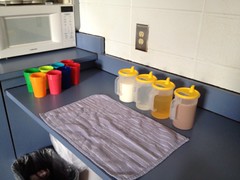 |
| Our "pouring station" |
Pretend Play
Children with autism often have difficulty pretending. They don't always use toys the way typical children do - give them a tea set and they may bang the cup on the table, spin the plate, etc. rather than pretend to pour or drink tea. They don't intuitively associate the toy pieces with real-life situations or they don't know what to do with the toys. One thing that we work on in my classroom is learning *how* to play appropriately. Here is one way I address that - by providing visual prompts of what to do with the toys!
Initially a paraprofessional, peer buddy, or myself will work with the student - pointing out different things that the child can do with the toy as well as modeling, prompting and reinforcing appropriate play. In addition to practicing "pretending", there are tons of opportunities for working on communication - expressive and receptive - while playing. We work on identifying items or following directions that involve discrimination using these toys and visuals (tell the student to "brush the dog" - they have to locate the brush, locate the dog, and perform the action). We point to a picture and ask "What can you do?" and they have to describe the picture (i.e. wash dishes). We use the knife to pretend to cut food and ask "What am I doing?" and the student tells us "cutting". Or we put the hat on the baby and ask the student to "show me what I'm doing" and they point to the correct picture on the visual. When the student becomes more proficient at playing, they play independently or with other students and the visuals serve as reminders for them.
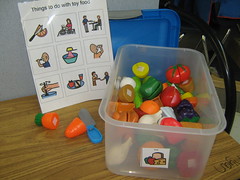
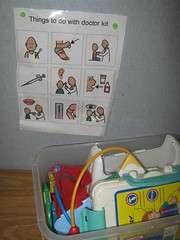
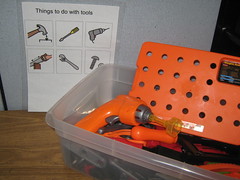
How do I determine what to include on the visual prompt? The best way I've found is to watch typical kids playing with a similar toy and note what kinds of things they do!
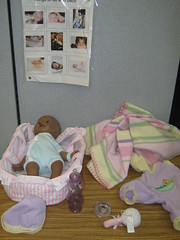
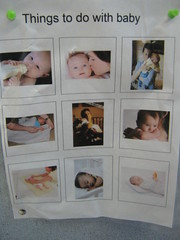
Some of these particular visuals were made with photos found on the internet, others use boardmaker symbols - you could take photos of yourself or someone else playing with the actual toy pieces you have, use drawings, or whatever works for your students!
I store the visual in the tub with the toys so that it's always available at playtime!
